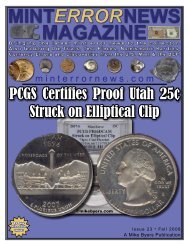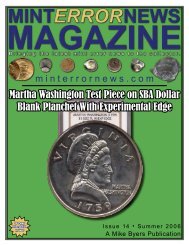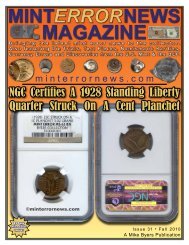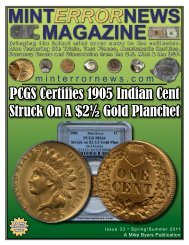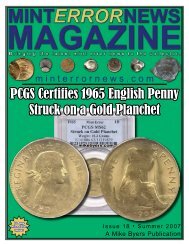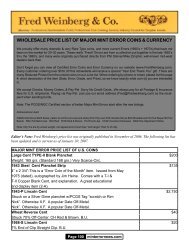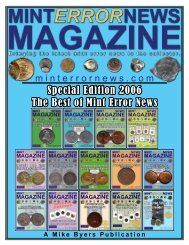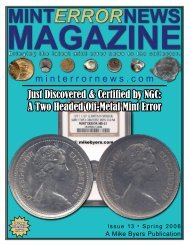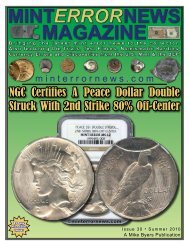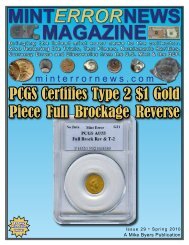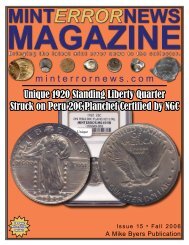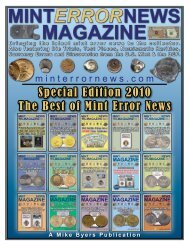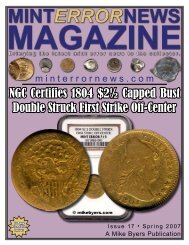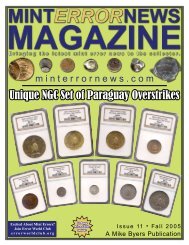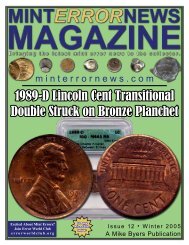Issue 1 - Mint Error News Magazine
Issue 1 - Mint Error News Magazine
Issue 1 - Mint Error News Magazine
Create successful ePaper yourself
Turn your PDF publications into a flip-book with our unique Google optimized e-Paper software.
“Shrunken Coins”<br />
and How to Recognize Them<br />
What are they?<br />
Shrunken coins are genuine<br />
coins that have been reduced to 65-<br />
95% of their original diameter using<br />
huge magnetic fields. Over the last<br />
year, we began offering shrunken<br />
coins as educational, scientific, and<br />
coin collecting novelties. A significant<br />
number of these are now<br />
in the hands of experimenters and<br />
collectors throughout the world.<br />
Shrunken coins have been featured<br />
in Coin World (November 25, 2002)<br />
and in the January-March, 2003 issue<br />
of Extraordinary Technology<br />
magazine. This article will briefly<br />
explain how these unique coins<br />
are produced and how they can be<br />
recognized so that they won’t be<br />
confused with true error coins.<br />
Are there any shrunken error<br />
coins?<br />
We don’t shrink error coins<br />
since the shrinking process relies<br />
upon symmetry for balancing<br />
forces. It would also be a shame to<br />
further alter rare error coins. However,<br />
once in a while the shrinking<br />
process fails to work properly on a<br />
coin that otherwise appears normal.<br />
For example, clad coins sometimes<br />
contain hidden defects that are not<br />
readily apparent. During the shrinking<br />
process, the inner and outer layers<br />
may partially detach, resulting<br />
in a very strange looking “mutant<br />
coin”, such as this Kentucky state<br />
quarter.<br />
Do you suppose there might<br />
be a market for “error” shrunken<br />
coins??<br />
How are they shrunk?<br />
Everyone has played with a<br />
pair of permanent magnets and felt<br />
how strongly they attract or repel<br />
each other. Although the forces<br />
that repel small magnets may appear<br />
quite strong, magnetic fields<br />
that are thousands of times stronger<br />
can be created by forcing an electric<br />
current through a coil of wire,<br />
forming a powerful electromagnet.<br />
Increasing the current increases the<br />
magnetic field, and a really huge<br />
current can create an ultrastrong<br />
magnetic field. Magnetic fields of<br />
this magnitude have the ability to<br />
overcome the yield strength of any<br />
metal. Although it may be hard to<br />
believe, a properly-shaped ultrastrong<br />
magnetic field can actually<br />
reshape a coin using only invisible<br />
Page 12 minterrornews.com<br />
by Bert Hickman<br />
“dies” of pure magnetic force!<br />
Prior to shrinking, a coin<br />
is carefully centered within a coil<br />
of insulated copper wire. The coil<br />
is then bolted securely to heavy<br />
electrical conductors inside a bulletproof<br />
blast chamber. Using a<br />
high voltage energy source, a huge<br />
current is abruptly forced into the<br />
coil, creating an ultrastrong pulsed<br />
magnetic field. The peak current<br />
through the coil may be greater than<br />
120,000 times the current drawn by<br />
a typical 100-watt light bulb. This<br />
rapidly changing powerful magnetic<br />
field also induces an even larger<br />
current to flow within the coin. The<br />
current flowing within the coin can<br />
easily exceed one million amperes,<br />
causing the coin to become a powerful<br />
electromagnet as well.<br />
The magnetic fields of the<br />
coil and the coin violently repel each<br />
other, resulting in almost unimaginable<br />
forces that easily overcome<br />
the yield strength of the metal in the<br />
coin. These forces evenly squeeze<br />
the coin inward, almost instantly<br />
shrinking it into a smaller diameter<br />
while simultaneously causing it to<br />
become thicker. These same forces<br />
also drive the coil outwards, causing<br />
it to explode in a potentially deadly<br />
spray of high velocity wire fragments.<br />
All this takes place in about<br />
20 millionths of a second, and is<br />
accompanied by a bright blue-white<br />
flash and a loud BANG! When the<br />
dust settles, a hot and shrunken coin



